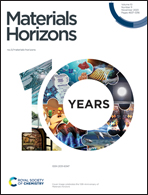An adhesive peptide specifically induces microtubule condensation†
Abstract
Cell function-associated biomolecular condensation has great potential in modulation of molecular activities. We develop a microtubule-trapping peptide that first self-assembles into nanoparticles and then in situ transforms into nanofibers via ligand–receptor interactions when targeted to tubulin. The nanofibers support the increased exposed targets for further adhering to microtubules and induce the self-assembly of microtubules into networks due to multivalent effects. Microtubule condensation with prolonged retention in cells for up to 24 h, which is 6 times longer than that of the non-transformable nanoparticle group, efficiently induces in vitro cell apoptosis and inhibits in vivo tumour growth. These smart transformable peptide materials for targeted protein condensation have the potential for improving retention and inducing cell apoptosis in tumour therapy.



 Please wait while we load your content...
Please wait while we load your content...